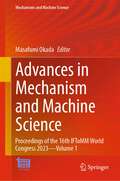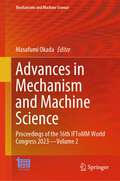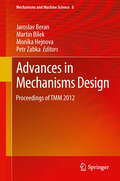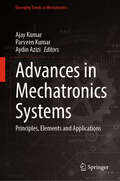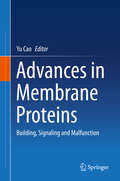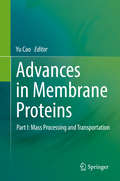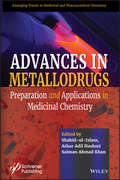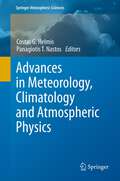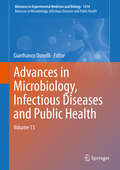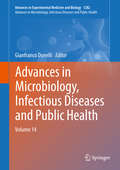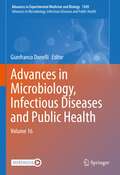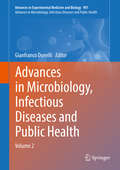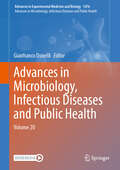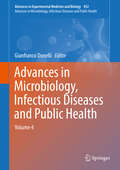- Table View
- List View
Advances in Mechanism and Machine Science: Proceedings of the 16th IFToMM World Congress 2023—Volume 1 (Mechanisms and Machine Science #147)
by Masafumi OkadaThis book gathers the proceedings of the 16th IFToMM World Congress, which was held in Tokyo, Japan, on November 5–10, 2023. Having been organized every four years since 1965, the Congress represents the world’s largest scientific event on mechanism and machine science (MMS). The contributions cover an extremely diverse range of topics, including biomechanical engineering, computational kinematics, design methodologies, dynamics of machinery, multibody dynamics, gearing and transmissions, history of MMS, linkage and mechanical controls, robotics and mechatronics, micro-mechanisms, reliability of machines and mechanisms, rotor dynamics, standardization of terminology, sustainable energy systems, transportation machinery, tribology and vibration. Selected by means of a rigorous international peer-review process, they highlight numerous exciting advances and ideas that will spur novel research directions and foster new multidisciplinary collaborations.
Advances in Mechanism and Machine Science: Proceedings of the 16th IFToMM World Congress 2023—Volume 2 (Mechanisms and Machine Science #148)
by Masafumi OkadaThis book gathers the proceedings of the 16th IFToMM World Congress, which was held in Tokyo, Japan, on November 5–10, 2023. Having been organized every four years since 1965, the Congress represents the world’s largest scientific event on mechanism and machine science (MMS). The contributions cover an extremely diverse range of topics, including biomechanical engineering, computational kinematics, design methodologies, dynamics of machinery, multibody dynamics, gearing and transmissions, history of MMS, linkage and mechanical controls, robotics and mechatronics, micro-mechanisms, reliability of machines and mechanisms, rotor dynamics, standardization of terminology, sustainable energy systems, transportation machinery, tribology and vibration. Selected by means of a rigorous international peer-review process, they highlight numerous exciting advances and ideas that will spur novel research directions and foster new multidisciplinary collaborations.
Advances in Mechanisms Design: Proceedings of TMM 2012 (Mechanisms and Machine Science #8)
by Jaroslav Beran Martin Bílek Monika Hejnova Petr ZabkaThe International Conference on the Theory of Machines and Mechanisms is organized every four years, under the auspices of the International Federation for the Promotion of Mechanism and Machine Science (IFToMM) and the Czech Society for Mechanics. This eleventh edition of the conference took place at the Technical University of Liberec, Czech Republic, 4-6 September 2012. This volume offers an international selection of the most important new results and developments, in 73 papers, grouped in seven different parts, representing a well-balanced overview, and spanning the general theory of machines and mechanisms, through analysis and synthesis of planar and spatial mechanisms, dynamics of machines and mechanisms, linkages and cams, computational mechanics, rotor dynamics, biomechanics, mechatronics, vibration and noise in machines, optimization of mechanisms and machines, control and monitoring systems of machines, accuracy and reliability of machines and mechanisms, robots and manipulators to the mechanisms of textile machines.
Advances in Mechatronics Systems: Principles, Elements and Applications (Emerging Trends in Mechatronics)
by Ajay Kumar Aydin Azizi Parveen KumarThis book consists of eleven chapters that covers all aspects of mechatronics systems from basics to advanced. This book is an edited compilation of original research and applications backed with experimental, numerical and theoretical data on mechatronics systems, suitably categorized into sections of closely related topics, contributed by researchers, academics, scientists, industrialists and professionals from the field on various aspects of mechatronics. Therefore, it will provide logical, technical as well as analytical solutions and ideas to complex problems faced by researchers in the field of mechatronics. The academicians and students will get a comprehensive update on the state-of-the-art in this area and ample ideas for further research and innovation in mechatronics.
Advances in Medical Physics and Healthcare Engineering: Proceedings of AMPHE 2020 (Lecture Notes in Bioengineering)
by Siddhartha Bhattacharyya Moumita Mukherjee J. K. Mandal Christian Huck Satarupa BiswasThis book presents research advances in the theory of medical physics and its application in various sectors of biomedical engineering. It gathers best selected research papers presented at International Conference on Advances in Medical Physics and Healthcare Engineering (AMPHE 2020), organized by the Department of Physics (in collaboration with the School of Engineering and Technology) Adamas University, Kolkata, India. The theme of the book is interdisciplinary in nature; it interests students, researchers and faculty members from biomedical engineering, biotechnology, medical physics, life sciences, material science and also from electrical, electronics and mechanical engineering backgrounds nurturing applications in biomedical domain.
Advances in Medicine and Medical Research (Advances in Experimental Medicine and Biology #1133)
by Mieczyslaw PokorskiThis book focuses on issues in clinical practice and research that are of general interest. The articles primarily focus on understanding the pathogenic mechanisms of diseases, their prevention, and therapy. The topics addressed include cardiovascular regulation with regard to blood pressure and heart rate variability, and to coupling blood pressure changes with subarachnoid fluid oscillations. In addition, the book discusses recent advances in the diagnostics of and targeted molecular therapy for renal and pancreatic malignancies, growth disorders, vitamin D and calcium homeostasis in children in the context of neonatal urolithiasis, and neurosurgical interventions in multifarious age-related diseases of the vertebrae. Neuropsychological aspects of patients’ quality of life and of shaping medical staff’s attitude toward patients are also addressed. The respective articles are intended to build a bridge between basic and clinical research. Further, the book enhances the current body of knowledge on diagnostics and patient treatment and offers valuable new perspectives on practical clinical issues. As such, it offers a unique resource for clinicians, family physicians, medical scholars, and professionals engaged in patient management.
Advances in Membrane Proteins: Building, Signaling and Malfunction
by Yu CaoThis book reviews recent advances regarding the biochemical and biophysical properties of membrane proteins and their applications in biomedicine. Divided into two thematic parts, this second volume addresses proteins’ formation, signaling and malfunctions. It covers a number of important membrane proteins including receptors, cell adhesion molecules, single-transmembrane proteins and viral membrane proteins, and discusses their structures, functions, related diseases, and roles in drug discovery in detail. In turn, the book elucidates the lifecycle of membrane proteins, including their synthesis and facilitated folding process, as well as QC procedures for their production. Additional topics include fundamental concepts, the latest findings, and critical puzzles yet to be solved. Given its scope, the book will appeal to a broad readership in the field of membrane structural and functional biology. Junior scientists can use it as an introduction to the field, while advanced scientists will find a broader view of the field beyond their area of specialization.
Advances in Membrane Proteins: Part I: Mass Processing and Transportation
by Yu CaoThe book summarizes advances in biochemical and biophysical property of membrane proteins as well as their applications in biomedicine. It is organised into 2 themed parts. This part focuses on mass processing and transportation and provides deep and comprehensive information on specific groups of membrane proteins including channels and transporters, nuclear and cytoplasmic membrane proteins, and membrane embedded enzymes. Their structures, functions, related diseases as well as their roles in drug discovery are fully discussed. Interesting topics cover fundamental concepts, latest progress and critical puzzles yet to be solved. This work will appeal to a wide readership within the membrane structural and functional biology field. Junior scientists could use it to fast track into the field. Advanced scientists will find it helpful to gain a broader view of the field beyond their area of specialization.
Advances in Mesenchymal Stem Cells and Tissue Engineering: Volume 4 (Advances in Experimental Medicine and Biology)
by Phuc Van PhamThe fourth volume in this series is a proceedings volume based on papers presented at the 5th Innovations in Regenerative Medicine and Cancer Research conference. Chapters are written by some of the most innovative minds in stem cell and tissue engineering research, and provide a comprehensive overview of papers from the most recent conference. The volume addresses tissue engineering principles and applications, including current trends and challenges, as well as future directions. Cutting edge topics of interest include production of functional tissues, vascularization and immune responses, and functionalization of scaffolds. Volumes in this series are invaluable resources for active researchers, clinicians, and professionals in industry, as well as students across a broad range of fields.
Advances in Metabolomics
by Vijai SinghThe book delves into metabolomics which is a rapidly growing field that focuses on the study of chemical processes involving metabolites. These metabolites are small molecules that serve as substrates, intermediates, and end products of cellular metabolism. The book covers a wide range of tools and methods to facilitate metabolomics analysis, including modelling, gas chromatography, GC-MS, HPLC, MALDI, nuclear magnetic resonance, and many others. The book introduces metabolomics and then delves into tools and methods used in metabolomics research, followed by genome-scale analysis and fluxomics, which explore the complex metabolic networks within cells. The design of biosynthetic pathways is discussed in detail, highlighting their significance in manipulating cellular metabolism. The book also explores biosensors, chromatography techniques, NMR spectroscopy, transcriptional control of metabolite production, microfluidics, and the role of artificial intelligence and machine learning in metabolomics research. Additionally, it delves into cell-free systems, bioprocess optimization, fermentation technology, and industrial-scale production of metabolites. This book fills a significant gap in the market with comprehensive coverage and inclusion of diverse topics making it a valuable resource for students, researchers, scientists, clinicians, policymakers, and practitioners in the field.
Advances in Metal Forming: Expert System for Metal Forming (Springer Series in Materials Science #206)
by Rahulkumar Shivajirao HingoleThis comprehensive book offers a clear account of the theory and applications of advanced metal forming. It provides a detailed discussion of specific forming processes, such as deep drawing, rolling, bending extrusion and stamping. The author highlights recent developments of metal forming technologies and explains sound, new and powerful expert system techniques for solving advanced engineering problems in metal forming. In addition, the basics of expert systems, their importance and applications to metal forming processes, computer-aided analysis of metalworking processes, formability analysis, mathematical modeling and case studies of individual processes are presented.
Advances in Metallacrown Chemistry
by Curtis M. ZaleskiThis volume focuses on recent developments in metallacrown chemistry. While the field was established in 1989 by Professor Vincent Pecoraro and numerous applications had been proposed, there has been a recent surge in the practical applications for this class of molecules. Written by leaders in the metallacrown chemistry field this book addresses recent developments. The single-molecule magnet properties of metallacrowns are presented along with discussions on their ability to bind DNA, as well as their potency to serve as building blocks for supramolecular structures. The volume is not only intended for those who work directly in the field of metallacrowns but it also appeals to those working in the aligned fields of metallamacrocyclic chemistry, self-assembly chemistry, and supramolecular chemistry. This dedicated volume serves as an encyclopedic reference for those wishing to gain insight into the field.
Advances in Metallic Biomaterials: Processing and Applications (Springer Series in Biomaterials Science and Engineering #4)
by Mitsuo Niinomi Takayuki Narushima Masaaki NakaiThis book reviews fundamental advances in the use of metallic biomaterials to reconstruct hard tissues and blood vessels. It also covers the latest advances in representative metallic biomaterials, such as stainless steels, Co-Cr alloys, titanium and its alloys, zirconium, tantalum and niobium based alloys. In addition, the latest findings on corrosion, cytotoxic and allergic problems caused by metallic biomaterials are introduced. The book offers a valuable reference source for researchers, graduate students and clinicians working in the fields of materials, surgery, dentistry, and mechanics. Mitsuo Niinomi, PhD, D. D. Sc. , is a Professor at the Institute for Materials Research, Tohoku University, Japan. Takayuki Narushima, PhD, is a Professor at the Department of Materials Processing, Tohoku University, Japan. Masaaki Nakai, PhD, is an Associate Professor at the Institute for Materials Research, Tohoku University, Japan.
Advances in Metallodrugs: Preparation and Applications in Medicinal Chemistry
by Shahid-Ul-Islam Athar Adil Hashmi Salman Ahmad KhanThis book is organized into 12 important chapters that focus on the progress made by metal-based drugs as anticancer, antibacterial, antiviral, anti-inflammatory, and anti-neurodegenerative agents, as well as highlights the application areas of newly discovered metallodrugs. It can prove beneficial for researchers, investigators and scientists whose work involves inorganic and coordination chemistry, medical science, pharmacy, biotechnology and biomedical engineering.
Advances in Meteorology, Climatology and Atmospheric Physics (Springer Atmospheric Sciences)
by Costas G. Helmis Panagiotis T. NastosThis book essentially comprises the proceedings of the 11th International Conference of Meteorology, Climatology and Atmospheric Physics (COMECAP 2012) that is held in Athens from 30 May to 1 June 2012. The Conference addresses researchers, professionals and students interested in the following topics: Agricultural Meteorology and Climatology, Air Quality, Applied Meteorology and Climatology, Applications of Meteorology in the Energy Sector, Atmospheric Physics and Chemistry, Atmospheric Radiation, Atmospheric Boundary Layer, Biometeorology and Bioclimatology, Climate Dynamics, Climatic Changes, Cloud Physics, Dynamic and Synoptic Μeteorology, Extreme Events, Hydrology and Hydrometeorology, Mesoscale Meteorology, Micrometeorology/Urban Microclimate, Remote Sensing/ Satellite Meteorology and Climatology, Weather Analysis and Forecasting. The book includes all papers that have been accepted for presentation at the conference.
Advances in Methods and Applications of Quantum Systems in Chemistry, Physics, and Biology (Progress in Theoretical Chemistry and Physics #33)
by Jean Maruani Erkki Brändas Alexander V. Glushkov Olga Yu. KhetseliusThis book reviews the most significant advances in concepts, methods, and applications of quantum systems in a broad variety of problems in modern chemistry, physics, and biology. In particular, it discusses atomic, molecular, and solid structure, dynamics and spectroscopy, relativistic and correlation effects in quantum chemistry, topics of computational chemistry, physics and biology, as well as applications of theoretical chemistry and physics in advanced molecular and nano-materials and biochemical systems. The book contains peer-reviewed contributions written by leading experts in the fields and based on the presentations given at the Twenty-Fourth International Workshop on Quantum Systems in Chemistry, Physics, and Biology held in Odessa, Ukraine, in August 2019. This book is aimed at advanced graduate students, academics, and researchers, both in university and corporation laboratories, interested in state-of-the-art and novel trends in quantum chemistry, physics, biology, and their applications.
Advances in Methods and Applications of Quantum Systems in Chemistry, Physics, and Biology: Selected Proceedings of QSCP-XXV Conference (Toruń, Poland, June 2022) (Progress in Theoretical Chemistry and Physics #34)
by Jean Maruani Erkki J. Brändas Ireneusz Grabowski Karolina SłowikThis book contains peer-reviewed contributions based on talks presented at the 25th International Workshop on Quantum Systems in Chemistry, Physics, and Biology held in Toruń, Poland, in June 2022. The book reviews significant advances in concepts, methods, and applications of quantum systems in a broad variety of areas in modern chemistry, physics, and biology. In particular, it discusses atomic, molecular, and solid state structure, dynamics and spectroscopy, relativistic and correlation effects in quantum chemistry, topics of computational chemistry, physics, and biology, as well as applications of theoretical chemistry and physics in advanced molecular and nano-materials and biochemical systems. This book is aimed at advanced graduate students, academics, and researchers, both in university and corporation laboratories, interested in state of the art and novel trends in quantum chemistry, physics, and biology, and their applications.
Advances in Microbiology, Infectious Diseases and Public Health: Volume 13 (Advances in Experimental Medicine and Biology #1214)
by Gianfranco DonelliThis book series focuses on current progress in the broad field of medical microbiology, and covers both basic and applied topics related to the study of microbes, their interactions with human and animals, and emerging issues relevant for public health. Original research and review articles present and discuss multidisciplinary findings and developments on various aspects of microbiology, infectious diseases, and their diagnosis, treatment and prevention.The book series publishes review and original research contributions, short reports as well as guest edited thematic book volumes. All contributions will be published online first and collected in book volumes. There are no publication costs.Advances in Microbiology, Infectious Diseases and Public Health is a subseries of Advances in Experimental Medicine and Biology, which has been publishing significant contributions in the field for over 30 years and is indexed in Medline, Scopus, EMBASE, BIOSIS, Biological Abstracts, CSA, Biological Sciences and Living Resources (ASFA-1), and Biological Sciences. 2018 Impact Factor: 2.126.
Advances in Microbiology, Infectious Diseases and Public Health: Volume 14 (Advances in Experimental Medicine and Biology #1282)
by Gianfranco DonelliThis book series focuses on current progress in the broad field of medical microbiology, and covers both basic and applied topics related to the study of microbes, their interactions with human and animals, and emerging issues relevant for public health. Original research and review articles present and discuss multidisciplinary findings and developments on various aspects of microbiology, infectious diseases, and their diagnosis, treatment and prevention.Advances in Microbiology, Infectious Diseases and Public Health is a subseries of Advances in Experimental Medicine and Biology, which has been publishing significant contributions in the field for over 30 years and is indexed in Medline, Scopus, EMBASE, BIOSIS, Biological Abstracts, CSA, Biological Sciences and Living Resources (ASFA-1), and Biological Sciences. 2018 Impact Factor: 2.126.
Advances in Microbiology, Infectious Diseases and Public Health: Volume 15 (Advances in Experimental Medicine and Biology #1323)
by Gianfranco DonelliThis book series focuses on current progress in the broad field of medical microbiology, and covers both basic and applied topics related to the study of microbes, their interactions with human and animals, and emerging issues relevant for public health. Original research and review articles present and discuss multidisciplinary findings and developments on various aspects of microbiology, infectious diseases, and their diagnosis, treatment and prevention.The book series publishes review and original research contributions, short reports as well as guest edited thematic book volumes. All contributions will be published online first and collected in book volumes. There are no publication costs.Advances in Microbiology, Infectious Diseases and Public Health is a subseries of Advances in Experimental Medicine and Biology, which has been publishing significant contributions in the field for over 30 years and is indexed in Medline, Scopus, EMBASE, BIOSIS, Biological Abstracts, CSA, Biological Sciences and Living Resources (ASFA-1), and Biological Sciences. 2019 Impact Factor: 2.450. 5 Year Impact Factor: 2.324; Cite Score: 3.0;Eigenfactor Score: 0.03583; Article Influence Score: 0.603
Advances in Microbiology, Infectious Diseases and Public Health: Volume 16 (Advances in Experimental Medicine and Biology #1369)
by Gianfranco DonelliThis book series focuses on current progress in the broad field of medical microbiology, and covers both basic and applied topics related to the study of microbes, their interactions with human and animals, and emerging issues relevant for public health. Original research and review articles present and discuss multidisciplinary findings and developments on various aspects of microbiology, infectious diseases, and their diagnosis, treatment and prevention.The book series publishes review and original research contributions, short reports as well as guest edited thematic book volumes. All contributions will be published online first and collected in book volumes. There are no publication costs.Advances in Microbiology, Infectious Diseases and Public Health is a subseries of Advances in Experimental Medicine and Biology, which has been publishing significant contributions in the field for over 30 years and is indexed in Medline, Scopus, EMBASE, BIOSIS, Biological Abstracts, CSA, Biological Sciences and Living Resources (ASFA-1), and Biological Sciences. 2020 Impact Factor: 2.622. 5 Year Impact Factor: 3.049; Cite Score: 3.9;Eigenfactor Score: 0.03583; Article Influence Score: 0.602
Advances in Microbiology, Infectious Diseases and Public Health: Volume 17 (Advances in Experimental Medicine and Biology #1370)
by Gianfranco DonelliThis book series focuses on current progress in the broad field of medical microbiology, and covers both basic and applied topics related to the study of microbes, their interactions with human and animals, and emerging issues relevant for public health. Original research and review articles present and discuss multidisciplinary findings and developments on various aspects of microbiology, infectious diseases, and their diagnosis, treatment and prevention. The book series publishes review and original research contributions, short reports as well as guest edited thematic book volumes. All contributions will be published online first and collected in book volumes. There are no publication costs. Advances in Microbiology, Infectious Diseases and Public Health is a subseries of Advances in Experimental Medicine and Biology, which has been publishing significant contributions in the field for over 30 years and is indexed in Medline, Scopus, EMBASE, BIOSIS, Biological Abstracts, CSA, Biological Sciences and Living Resources (ASFA-1), and Biological Sciences. 2021 Impact Factor: 3.6505 Year Impact Factor: 3.634; Cite Score: 4.7; Eigenfactor Score: 0.04133; Article Influence Score: 0.713
Advances in Microbiology, Infectious Diseases and Public Health: Volume 2 (Advances in Experimental Medicine and Biology #901)
by Gianfranco DonelliThe Series will provide microbiologists, hygienists, epidemiologists and infectious diseases specialists with well-chosen contributed volumes containing updated information in the areas of basic and applied microbiology involving relevant issues for public health, including bacterial, fungal and parasitic infections, zoonosis and anthropozoonosis, environmental and food microbiology. The increasing threat of the multidrug-resistant microorganisms and the related host immune response, the new strategies for the treatment of biofilm-based, acute and chronic microbial infections, as well as the development of new vaccines and more efficacious antimicrobial drugs to prevent and treat human and animal infections will be also reviewed in this series in the light of the most recent achievements in these fields. Special attention will be devoted to the fast diffusion worldwide of the new findings of the most advanced translational researches carried out in the different fields of microbiological sciences, with the aim to promote a prompt validation and transfer at clinical level of the most promising experimental results.
Advances in Microbiology, Infectious Diseases and Public Health: Volume 20 (Advances in Experimental Medicine and Biology #1476)
by Gianfranco DonelliThis book series focuses on current progress in the broad field of medical microbiology, and covers both basic and applied topics related to the study of microbes, their interactions with human and animals, and emerging issues relevant for public health. Original research and review articles present and discuss multidisciplinary findings and developments on various aspects of microbiology, infectious diseases, and their diagnosis, treatment and prevention. The book series publishes review and original research contributions, short reports as well as guest edited thematic book volumes. All contributions will be published online first and collected in book volumes. There are no publication costs. Advances in Microbiology, Infectious Diseases and Public Health is a subseries of Advances in Experimental Medicine and Biology, which has been publishing significant contributions in the field for over 30 years and is indexed in Medline, Scopus, EMBASE, Biological Abstracts, CSA, Biological Sciences and Living Resources (ASFA-1), and Biological Sciences. Chapter 6 is available open access under a Creative Commons Attribution 4.0 International License via link.springer.com.
Advances in Microbiology, Infectious Diseases and Public Health: Volume 4 (Advances in Experimental Medicine and Biology #932)
by Gianfranco DonelliThe Advances in Microbiology, Infectious Diseases and Public Health Series will provide microbiologists, hygienists, epidemiologists and infectious diseases specialists with well-chosen contributed volumes containing updated information in the areas of basic and applied microbiology involving relevant issues for public health, including bacterial, fungal and parasitic infections, zoonoses and anthropozoonoses, environmental and food microbiology. The increasing threat of the multidrug-resistant microorganisms and the related host immune response, the new strategies for the treatment of biofilm-based, acute and chronic microbial infections, as well as the development of new vaccines and more efficacious antimicrobial drugs to prevent and treat human and animal infections will be also reviewed in this series in the light of the most recent achievements in these fields. Special attention will be devoted to the fast diffusion worldwide of the new findings of the most advanced translational researches carried out in the different fields of microbiological sciences, with the aim to promote a prompt validation and transfer at clinical level of the most promising experimental results.
